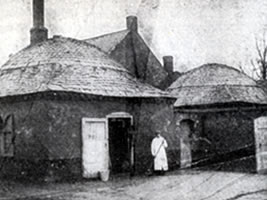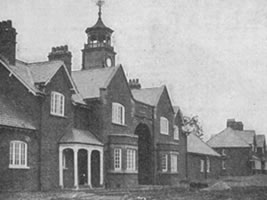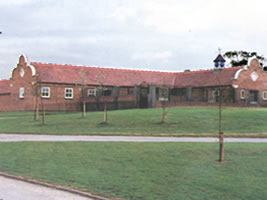History
The Quorn Hunt has a claim to be the oldest hunt in the country, being founded in 1696 by Mr Thomas Boothby of Tooley Park, Leicestershire. Tooley Park lies about eight miles southwest of Leicester, just to the north of the Hinckley road. The hunt takes its name from the village of Quorn, where the hounds were kennelled from 1753 to 1904.
 |
||
Kennels at Quorn Hall |
Two years after Mr Boothby's death, the son of a Lyttelton Poyntz Meynell, a certain Hugo Meynell first rented Quorn Hall. Such was his devotion to hunting that he became known as the Father of Foxhunting. His mastership of the Quorn ran from 1753/4 to 1799/1800.
The hunting country in High Leicestershire during Hugo Meynell’s day was open grassland with few roads, railways and houses. The only ancient woodland of any note was Old Dalby Wood – more extensive then than now. What changed the face of the countryside were the enclosures. The hunt needed places where a fox might lie and be easily found. The solution was sought and found in the making of new coverts, not less than two and no more than twenty acres in extent. The land became enclosed with hawthorn hedges which, when cut and laid, were not only stock proof but became a very inviting obstacle to jump. And so began the process of what can be seen in Leicestershire and beyond, even today: small woods surrounded by hedged pastureland.
Kirby Gate, the first turnpike gate on the Leicester road from Melton, became the site for the opening meet, and remains so to this day and Gartree Hill, traditionally the first draw. Melton became a mecca for foxhunters; with many fine hunt boxes (small manor houses) being established in and around the town by the country’s gentry. The visitors became known as Meltonians and drinking and carousing became the après-hunt activities of the day. The ‘mad’ Marquis of Waterford, who rented Lowesby Hall has two claims to fame in this neck of the woods – the first was to jump his horse over a farm gate in the main hall (the gate still remains at Lowesby and the gate jumping has recently been revised, not however, in the Hall but at an equestrian centre). The second was, together with his fellow Meltonians, to ride into Melton one dark night and paint the doors red – hence the expression ‘to paint the town red’.
A bit of trivia: John O’Gaunt Station, opened in 1895 and closed in 1952, was the only station in the country to be named after a fox covert that is situated a mile to the south. The station was also used to transport horses, in some luxury, by rail from London for a days hunting.
As the Quorn moved into the 20th Century, it became clear that new Kennels were needed: the old Kennels were in an inconvenient part of the Quorn country, the site was damp and thought bad for hounds, the buildings were obsolete, and the owner of Quorn Hall Mr E H Warner wanted the Kennels removed.
 |
||
Kennels at Pawdy crossroads |
The Quorn became probably the most famous hunt in the world and attracted visitors from all corners of the globe. Indeed at one time there was a waiting list of people wishing to subscribe. The then Prince of Wales (Edward VIII) met Wallis Simpson after a days hunting at Burrough Court and the present heir to the throne became a frequent visitor before the ban.
In the late 1980s, it had became clear that the Kennels at Pawdy crossroads
 |
||
Current Kennels at Kirby Bellars |
Things are not quite the same these days, the biggest blow being the ban on hunting with dogs. However, the hunt has survived and is now flourishing again and in rude health, albeit a tad more egalitarian, with members from across the spectrum of trades and professions and attracting many younger subscribers. With the goodwill of our farmers and landowners, who would not allow this traditional country sport to sink without trace, the hunt is still welcome to cross the land and jump fences, following hounds descended from Tom Boothby’s, but now following a pre-laid trail.
2011 is the 20th anniversary of the opening of the ‘new’ kennels at Kirby Bellars. The last 20 years, have indeed proved quite momentous; to the extent, at times, that it was touch and go whether hunting would survive.
Back in 1991, the Quorn Hunt was in confident mood, which manifested itself in the scale and size of the new kennels. Fields on Mondays and Fridays exceeded 100 riders, which included many ‘carpetbaggers’ from all over Britain and visitors from across the world, happy to pay caps to ride across the best of the best country. It was doubtful if anyone, at this time, could envisage this coming to an end.
There has been, and still is, incursion of modernisation into the countryside, with the roads becoming busier, village populations increasing with many newcomers not immersed in local traditions. The first bombshell to hit hunting was the outbreak of foot and mouth disease in February 2001 which affected most of the country and was not eradicated until October. Without doubt this had adverse effects on hunting – particularly hitting fundraising very hard. However, we picked ourselves up, shook ourselves down and carried on as normal. But, worse was yet to come, through an even greater threat by the Labour government’s Bill to ban hunting with dogs. But the countryside was not about to lie down and die, our farmers were not going to allow this vindictive Act change the face of the countryside. Yes, we had to change, and change we did.
After a few difficult years we are now as strong as ever and have developed into more of a local hunt and modernised to suit the times. The Act is flawed and we are now able to ‘hunt’ within the law. Some old-timers will inevitably say, “it’s not the same!” but our fields and caps are on the increase and with the goodwill of our farmers and landowners continue to enjoy ourselves in a free and unfettered manner. Our social structure has not only been maintained, but strengthened as can be seen by our increased number of events and functions.
We are all looking forward to the next 20 years.


